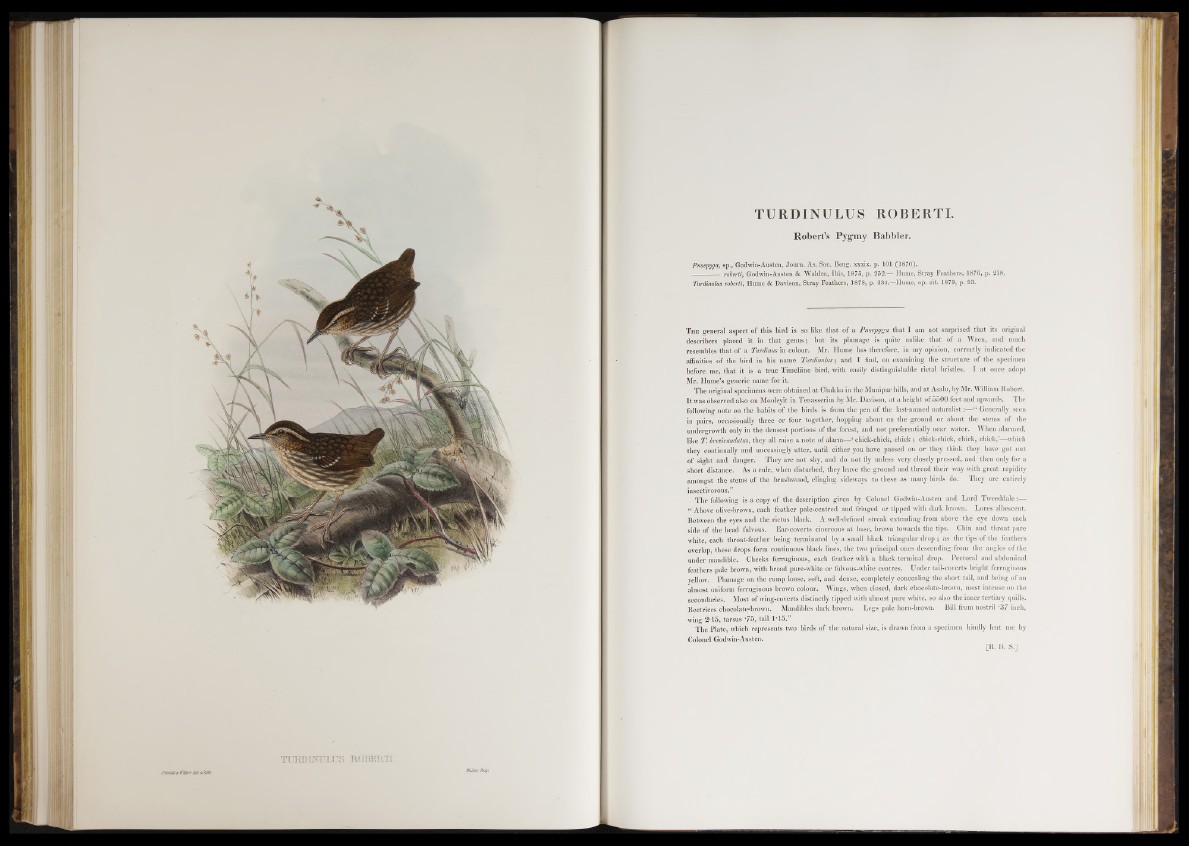
TURDINULUS ROBERTI .
Robert’s Pygmy Babbler.
Pnoepyga, sp., Godwin-Austen, Journ. As. Soc. Beng. xxxix. p. 101 (1870).
------------- roberti, Godwin-Austen & Walden, Ibis, 1875, p. 252.— Hume, Stray Feathers, 1876, p. 218.
Turdimhs roberti, Hume & Davison, Stray Feathers, 1878, p. 234.—Hume, op. cit. 1879, p. 93.
T h e general aspect o f this bird is so like that o f a Pnoepyga that I am not surprised that its original
describers placed it in that genus; but its plumage is quite unlike that of a Wren, and much
resembles that o f a Turdinus in colour. Mr. Hume has therefore, in my opinion, correctly indicated the
affinities of the bird in his name Turdinulus; and I find, on examining the structure of the specimen
before me, that it is a true Timeliine bird, with easily distinguishable rictal bristles. I at once adopt
Mr. Hume’s generic name for it.
The-original specimens were obtained at Chakha in the Munipur hills, and at Asalu, by Mr. William Robert.
It was observed also on Mooleyit in Tenasserim by Mr. Davison, at a height of 5500 feet and upwards. The
following note on the habits of the birds is from the pen o f the last-named n a turalist:— “ Generally seen
in pairs, occasionally three or four together, hopping about on the ground or about the stems of the
undergrowth only in the densest portions of the forest, and not preferentially near water. When alarmed,
like T. bremcaudatus, they all raise a note o f alarm—‘ chick-cbick, chick ; chick-chick, chick, chick,’—which
they continually and unceasingly utter, until either you have passed on or they think they have got out
o f sight and danger. They are not shy, and do not fly unless very closely pressed, and then only for a
short distance. As a rule, when disturbed, they leave the ground and thread their way with great rapidity
amongst the stems o f the brushwood, clinging sideways to these as many birds do. They are entirely
insectivorous.”
The following is a copy of the description given by Colonel Godwin-Austen and Lord Tweeddale:—
“ Above olive-brown, each feather pale-centred and fringed or tipped with dark brown. Lores albescent.
Between the eyes and the rictus black. A well-defined streak extending from above the eye down each
side of the head fulvous. Ear-coverts cinereous at base, brown towards the tips. Chin and throat pure
white, each throat-feather being terminated by a small black triangular drop ; as the tips of the feathers
overlap, these drops form continuous black lines, the two principal ones descending from the angles of the
under mandible. Cheeks ferruginous, each feather with a black terminal drop. Pectoral and abdominal
feathers pale brown, with broad pure-white or fulvous-white centres. Under tail-coverts bright ferruginous
yellow. Plumage on the rump loose, soft, and dense, completely concealing the short tail, and being of an
almost uniform ferruginous brown colour. Wings, when closed, dark chocolate-brown, most intense on the
secondaries. Most of wing-coverts distinctly tipped with almost pure white, so also the inner tertiary quills.
Rectrices chocolate-brown. Mandibles dark brown. Legs pale horn-brown. Bill from nostril 37 inch,
wing 2 -15, tarsus -75, tail 1*15.”
The Plate, which represents two birds of the natural size, is drawn from a specimen kindly lent me by
Colonel Godwin-Austen.
[R. B. S.]